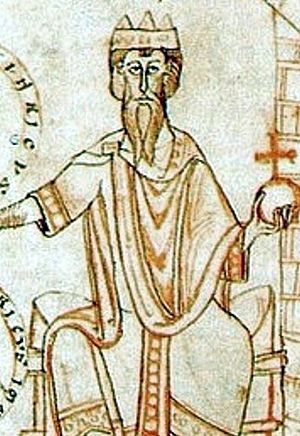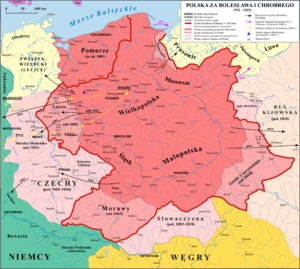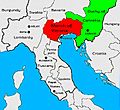Conrad II, Holy Roman Emperor facts for kids
Quick facts for kids Conrad II |
|
|---|---|

Miniature depiction, c. 1130
|
|
| Holy Roman Emperor | |
| Reign | 26 March 1027 – 4 June 1039 |
| Coronation | 26 March 1027 Old St. Peter's Basilica, Rome |
| Predecessor | Henry II |
| Successor | Henry III |
| King of Burgundy | |
| Reign | 6 September 1032 – 4 June 1039 |
| Predecessor | Rudolph III |
| Successor | Henry III |
| King of Italy | |
| Reign | 31 March 1026 – 4 June 1039 |
| Coronation | 31 March 1026 Basilica of Sant'Ambrogio, Milan |
| Predecessor | Henry II |
| Successor | Henry III |
| King of Germany | |
| Reign | 8 September 1024 – 4 June 1039 |
| Coronation | 8 September 1024 Mainz Cathedral, Mainz |
| Predecessor | Henry II |
| Successor | Henry III |
| Born | c. 989/990 Speyer, Duchy of Franconia, Kingdom of Germany, Holy Roman Empire |
| Died | 4 June 1039 (aged 48 or 49) Utrecht, Lower Lorraine, Kingdom of Germany, Holy Roman Empire |
| Burial | Speyer Cathedral |
| Spouse |
Gisela of Swabia
(m. 1016) |
| Issue | Henry III, Holy Roman Emperor Matilda of Franconia |
| House | Salian |
| Father | Henry, Count of Speyer |
| Mother | Adelaide of Metz |
Conrad II (born around 989/990 – died June 4, 1039) was an important ruler in medieval Europe. He was the Holy Roman Emperor from 1027 until his death. He was the first emperor from the Salian dynasty, a family that ruled for about 100 years.
Conrad II ruled over three kingdoms: Germany (starting in 1024), Italy (starting in 1026), and Burgundy (starting in 1033). His rule helped make the Holy Roman Empire strong and peaceful for a while.
Conrad was the son of Henry, Count of Speyer, and Adelaide of Metz. He became Count of Speyer and Worms when he was young. When Emperor Henry II died without children in 1024, the German princes chose Conrad, who was 34, to be their new king.
Conrad continued many of the old traditions of the emperors before him, especially how they worked with the Church. He also gained control of the Kingdom of Burgundy after its king died. These three kingdoms—Germany, Italy, and Burgundy—became the main parts of his empire.
Contents
Early Life and Family
Who were Conrad's parents?
The Salian family, which Conrad belonged to, came from a region in Germany called Franconia. Conrad's great-grandfather, Conrad the Red, was a duke and married a daughter of Emperor Otto I. This marriage connected Conrad's family to the powerful imperial family.
Conrad's father was Henry of Speyer, who died when Conrad was very young. His mother was Adelaide of Metz. After his father's death, his mother remarried, and Conrad's relationship with her became distant.
How did Conrad become important?
Conrad's grandfather, Otto of Worms, was also an important figure. He was a duke and a count. When Emperor Otto III died in 1002, Otto of Worms was considered for king, but he stepped aside for Henry IV (who became Emperor Henry II). This shows that Conrad's family was already well-known and respected among the German nobles.
In 1016, Conrad married Gisela of Swabia. She was a wealthy duchess who had been married twice before. Her family was also very important, and she was related to Charlemagne. This marriage brought Conrad more wealth and influence. However, their marriage was controversial because they were related, which was against church law at the time. Emperor Henry II even sent Conrad away for a short time because of this. Despite this, Gisela gave birth to their son, Henry III, in 1017, who would later become emperor.
Becoming King of Germany
How was Conrad chosen as king?
When Emperor Henry II died in 1024, he had no children. This meant the Ottonian dynasty, which had ruled Germany for a long time, had ended. The German dukes and princes gathered to choose a new king.
On September 4, 1024, the princes met near the Rhine River. Conrad was a candidate, and so was his younger cousin, also named Conrad. Both were related to Emperor Otto I. Most of the princes chose the elder Conrad (Conrad II) because he had a young son, which meant a more stable future for the kingdom.
Conrad was crowned King of Germany on September 8, 1024, in Mainz Cathedral. To celebrate his election, he ordered the building of Speyer Cathedral, which began in 1030.
Why was Gisela's coronation important?
The Archbishop of Mainz, who crowned Conrad, refused to crown Conrad's wife Gisela as queen. He believed their marriage was against church law. However, the Archbishop of Cologne saw this as a chance to improve his relationship with the new king. He crowned Gisela queen on September 21, 1024. This helped strengthen Conrad's position as king.
What challenges did Conrad face early on?
Conrad faced challenges from some dukes who didn't support him. To gain support, Conrad and Gisela traveled throughout Germany. They visited important bishops and nobles, securing their loyalty. He promised to respect the local customs and laws, especially in Saxony, which helped unite the nobles behind him.
Conrad also had to deal with a long-standing church dispute called the "Gandersheim Conflict." This was about who controlled a certain abbey. Conrad tried to solve it with church meetings, but it took several years to finally settle the issue.
Becoming Holy Roman Emperor
What happened in Italy?
After Henry II's death, Italy was restless. Many Italian nobles wanted to break away from the Holy Roman Empire. They even offered their crown to French princes, but they refused.
In February 1026, Conrad led a large army into Italy. He wanted to show his power and claim the Italian crown. He besieged the city of Pavia, which had rebelled. In March 1026, he was crowned King of the Lombards in Milan.
When was Conrad crowned Emperor?

On March 26, 1027, Pope John XIX crowned Conrad and Gisela as Emperor and Empress in Old St. Peter's Basilica in Rome. This was a very important event, attended by many powerful people, including Cnut the Great, King of England, Denmark, and Norway.
After his coronation, Conrad made changes to how monasteries and church areas in Italy were organized. He wanted to bring them under imperial control. He also traveled south to receive loyalty from the princes in Southern Italy.
How did Conrad strengthen his family's power?
Conrad returned to Germany in May 1027. He made a bold move by appointing his 10-year-old son, Henry, as the new Duke of Bavaria. This was unusual because there were other older, more experienced candidates. This decision helped Conrad gain more control over the southern parts of Germany.
Conrad also demanded that all imperial property in Bavaria be documented. This caused some tension with the German nobles, who felt he was taking too much power.
Challenges and Conflicts
What was the Swabian uprising?
In 1025, Conrad's stepson, Ernest II, Duke of Swabia, rebelled against him. Conrad defeated him, but Ernest joined other rebels later. When Conrad returned from Italy in 1027, he called for the rebels to surrender. Ernest refused, but his own nobles would not fight against the Emperor.
Ernest, along with his allies, surrendered to Conrad in Worms. Conrad took away Ernest's ducal title and put him in prison. However, Gisela, Ernest's mother, asked Conrad to be lenient. Ernest was allowed to keep his title while imprisoned, and Gisela ruled Swabia for him.
In 1028, Conrad pardoned Ernest and released him. But when Ernest refused to help Conrad against his enemies, Conrad stripped him of his title again and declared him a public enemy. Ernest was later killed in battle. Conrad then appointed Ernest's younger brother, Herman, as the new Duke of Swabia. Later, Conrad's own son Henry became Duke of Swabia, giving Conrad even more control.
How did Conrad deal with Duke Adalbero?
Conrad also faced problems with Duke Adalbero of Carinthia. Adalbero started acting like his duchy was an independent state. He even tried to make peace with Hungary, which was raiding the Empire's borders.
Conrad accused Adalbero of treason in 1035 and wanted to take away his titles and lands. Conrad's son Henry at first refused to support this, but eventually agreed. Adalbero was removed as duke and sent into exile. Conrad then appointed his cousin, Conrad the Younger, as the new Duke of Carinthia. This meant that all three southern German duchies (Swabia, Bavaria, and Carinthia) were now controlled by Conrad's family.
Conrad's way of dealing with rebellious nobles was stricter than previous emperors. He used treason trials to declare them "public enemies," which was seen as harsh by some nobles.
What was Conrad's church policy?
Conrad continued the tradition of using the German Church to help him rule the Empire. Emperors often gave church officials important positions and land, making them loyal to the emperor. In return, these officials provided services like hospitality and soldiers for the army.
However, Conrad was less interested in founding new monasteries than previous emperors. He also let his wife Gisela influence some church decisions. For example, when the Archbishop of Mainz died, Gisela convinced Conrad to appoint Bardo instead of another theologian Conrad preferred.
Relations with Eastern Europe
Wars with Poland
Poland and the Holy Roman Empire had a long history of conflict. In 1018, a peace treaty was signed, but after Emperor Henry II died in 1024, the Polish Duke Bolesław I crowned himself King of Poland. This was seen as a challenge to Conrad's authority.
Bolesław died soon after, and his son Mieszko II became king. Mieszko expelled his half-brother Otto, who then sought Conrad's protection. Conrad saw Mieszko's claim to be "king" as an act of war.
In 1028, Mieszko invaded parts of the eastern Empire. Conrad responded by forming a closer relationship with King Cnut of England and Denmark. In 1029, Conrad invaded Poland but had to retreat. In 1030, Poland allied with Hungary, and both attacked the Empire. Conrad then allied with Yaroslav the Wise, the Grand Prince of Kiev, who attacked Poland from the east.
In 1031, Conrad made peace with Hungary and focused on Poland. He besieged Bautzen again. Mieszko was defeated and surrendered. Under the Treaty of Merseburg, Mieszko had to give back territories to the Empire.
The Treaty of Merseburg
After the peace treaty, Mieszko was overthrown by his exiled brother Bezprym, who had help from Kiev. Bezprym sent the Polish royal symbols to Conrad, giving up the title of "king" and accepting the Empire's rule over Poland.
However, Bezprym's rule was short and cruel. He was murdered in 1032. Conrad then held a meeting in Merseburg in 1033 to decide Poland's future. Conrad's wife, Empress Gisela, asked for Mieszko to be released from prison and returned to the Polish throne. Under the Treaty of Merseburg, Conrad divided Poland among Mieszko and his two half-brothers. Mieszko was allowed to be Duke and had some authority over all of Poland.
Mieszko later reunited Poland after his brothers died or were expelled. He continued to call himself King. Mieszko died in 1034, and his wife and son fled to the Empire due to unrest in Poland.
Bohemia and Hungary
The Duchy of Bohemia was part of the Holy Roman Empire. In 1033, the Bohemian Duke Oldřich refused to attend an assembly called by Conrad. Conrad sent his son Henry, who was only 17, to punish Bohemia. Henry successfully removed Oldřich and put his brother Jaromír on the throne. This was Henry's first independent military command.
Relations with Hungary became difficult under Conrad. Emperor Henry II had been Stephen I of Hungary's brother-in-law, so relations were friendly. But Conrad had a more aggressive policy. In 1030, Conrad invaded Hungary, but the Hungarians used a "scorched earth" tactic, burning their own lands to deny resources to Conrad's army, forcing him to retreat. Conrad's son Henry later settled the conflict, and peace lasted until Henry became emperor.
Conquest of Burgundy
How did Conrad gain Burgundy?
In 1016, King Rudolph III of Burgundy had no male heir. He was forced by Emperor Henry II to name him as his successor. Henry II died before Rudolph, so Conrad II claimed the right to Burgundy. Another count, Odo II of Blois, also claimed the throne.
Conrad met Rudolph in 1027, and they agreed that Conrad would become king of Burgundy after Rudolph's death, just as Henry II would have.
Rudolph died in 1032. Conrad was busy fighting in Poland, but he marched his army to Burgundy in the winter. Odo II had already invaded parts of Burgundy. On February 2, 1033, Conrad was crowned King of Burgundy. After two large military campaigns, Conrad defeated Odo. On August 1, 1034, Conrad officially added Burgundy to the Holy Roman Empire.
Even though Burgundy was now part of the Empire, it was allowed to keep a lot of its independence. Conrad rarely interfered in its affairs. The control of Burgundy was important because it gave the Emperor control over the western mountain passes into Italy, making it easier to defend the Empire.
Later Years and Death
Securing the future of the Empire
Conrad made sure his son Henry would follow him as emperor. In 1028, he had Henry elected and crowned King of Germany in Aachen. Henry married Gunhilda of Denmark, the daughter of King Cnut the Great. This marriage helped strengthen ties with the powerful kingdoms of England, Denmark, and Norway. Henry became his father's main advisor.
Last expedition to Italy
In 1038, Conrad went to Southern Italy to settle a dispute. He helped one prince, Guaimar IV of Salerno, against another, Pandulf IV of Capua. Conrad besieged and conquered Capua and gave it to Guaimar. This helped ensure that Southern Italy remained loyal to the Holy Roman Empire.
How did Conrad II die?

On his way back to Germany, many of Conrad's soldiers died from a severe illness. His daughter-in-law and stepson also died. Conrad himself returned safely.
A year later, in 1039, Conrad became ill and died of gout in Utrecht. His body was taken to Speyer Cathedral, which was still being built. He was buried there, and his tomb can still be seen today in the crypt, along with those of seven later emperors.
A biography of Conrad II was written by his chaplain, Wipo of Burgundy, for Conrad's son, Henry III.
Family and Children
Conrad married Gisela of Swabia in 1016. They had three children:
- Henry III (1017–1056)
- Beatrix (around 1020–1036)
- Matilda (around 1027–1034)
Images for kids
-
Speyer Cathedral, consecrated in 1061
-
Conrad II, 12th-century stained glass window, Strasbourg Cathedral
-
Emperor Conrad disapproved of Duke Adalbero's increasingly independent rule of his estates Carinthia and Verona.
|
Conrad II, Holy Roman Emperor
Born: c 990 Died: 1039 |
||
| Regnal titles | ||
|---|---|---|
| Vacant
Title last held by
Henry the Saint |
King of Germany 1024–1039 with Henry III (1028–1039) |
Succeeded by Henry the Black |
| Holy Roman Emperor 1027–1039 |
Vacant
Title next held by
Henry the Black |
|
| King of Italy 1027–1039 |
||
| Preceded by Rudolph the Pious |
King of Burgundy 1032–1039 with Henry the Black (1038–1039) |
|
See also
 In Spanish: Conrado II para niños
In Spanish: Conrado II para niños









